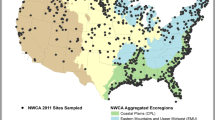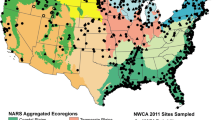Abstract
Under current U.s. wetland delineation procedures, an area must have hydric soils, wetland hydrology, and hydrophytic vegetation to be considered a wetland. This study investigated the level of correlation between these three parameters on sites disturbed by humans versus relatively undisturbed sites. Based on our data set of nearly 1,800 data points from 188 sites in northeastern Illinois and northwestern Indiana, USA, relatively “disturbed” locations are significantly less likely to meet all three wetland criteria than “undisturbed” locations. Disturbance also affects an area’s likelihood to meet or fail particular wetland parameters, depending on the type of disturbance. Also, areas dominated by common hydrophytic species are significantly less likely to meet all three wetland criteria in disturbed areas versus undisturbed areas. This study suggests the need for quantitative studies of the three wetland criteria on both disturbed and undisturbed sites to refine further the USFWS wetness ratings and hydric soil field indicators relative to the effects of disturbance.
Similar content being viewed by others
Literature Cited
Adamus, P. R. 1998. Condition, values, and loss of natural functions of prairie wetlands of the north-central United States. U.S. Environmental Protection Agency, Office of Water. On the internet at: http://www.epa.gov/OWOW/wetlands/wqual/appendixb.html#4.2.
Bunting, M. J., C. R. Morgan, M. van Bakel, and B. G. Warner. 1998. Pre-European settlement conditions and human disturbance of a coniferous swamp in southern Ontario. Canadian Journal of Botany 76:1770–79.
Campbell, R. C. 1989. Statistics for Biologists, third edition. Cambridge University Press, Cambridge, England.
Cochran, W. G. and G. M. Cox. 1966. Experimental Designs, second edition. John Wiley & Sons, Inc., New York, NY, USA.
Cody, R. P. and J. K. Smith. 1997. Applied Statistics and the SAS Programming Language, fourth edition. Prentice-Hall, Inc., Upper Saddle River, NJ, USA.
Cowardin, L. M., V. Carter, F. C. Golet, and E. T. LaRoe. 1979. Classification of wetlands and deepwater habitats of the United States. U.S. Fish and Wildlife Serfice, Northern Prairie Wildlife Research Center, Jamestown, ND, USA. FWS/OBS-79/31. On the internet at: http://www.nwi.fws.gov/classifman/classmanual.htm.
Dulohery, C. J., L. A. Morris, and R. Lowrance. 1996. Assessing forest soil disturbance through biogenic gas fluxes. Soil Science Society of America Journal 60:291–98.
Emers, M., J. C. Jorgenson, and M. K. Raynolds. 1995. Response of arctic tundra plant communities to winter vehicle disturbance. Canadian Journal of Botany 73:905–17.
Environmental Laboratory. 1987. Corps of Engineers wetlands delineation manual. Army Engineer Waterways Experiment Station, Wetlands Research Program, Vicksburg, MS, USA. WES/TR/Y-87-1.
Fennessy, S. 1998a. Testing the Foristic Quality Assessment Index as an indicator of riparian wetland quality. Final report to the USEPA. Ohio EPA, Division of Surface Water, Columbus, OH, USA. EPA/CD995927/01.
Fennessy, S. 1998b. An ecological assessment of wetlands using reference sites, volumes 1 and 2. Final report to the USEPA, Ohio EPA, Division of Surface Water, Columbus, OH, USA. EPA/CD995761/01.
Forstall, R. L. (ed.). 1995. Population of counties by decennial census: 1900 to 1990. Population Division, U.S. Bureau of the Census. On the internet at: http://www.census.gov/population/cencounts/il 190090.txt.
Goddard, T. M. 1979. Soil survey of Kane County, Illinois. U.S. Department of Agriculture, Soil Conservation Service. U.S. Government Printing Office, Washington, DC, USA.
Holland, C. C., J. Honea, S. E. Gwin, and M. E. Kentula. 1995. Wetland degradation and loss in the rapidly urbanizing area of Portland, Oregon. Wetlands 15:336–345.
Hurt, G. W., P. M. Whited, and R. F. Pringle (eds.). 1998. Field indicators of hydric soils in the United States, version 4.0. USDANRCS, Ft. Worth, TX, USA.
Jorgensen, E. E. and L. E. Nauman. 1994. Disturbance in wetlands associated with commercial cranberry (Vaccinium macrocarpon) production. American Midland Naturalist 132:152–8.
Mapes, D. R. 1979. Soil survey of DuPage and part of Cook County, Illinois. U.S. Government Printing Office, Washington, DC, USA.
Mitsch, W. J. and J. G. Gosselink. 1993. Wetlands, second edition. Van Nostrand Reinhold, New York, NY, USA.
Moran, R. C. 1980. Presettlement (1830) vegetation of De Kalb, Kane, and Du Page Counties, Illinois. Department of Botany in the Graduate School, Southern Illinois University, Carbondale, IL, USA.
Mushet, D. M., N. H. Euliss, Jr., and T. L. Shaffer. 2002. Floristic quality assessment of one natural and three restored wetland complexes in North Dakota, USA. Wetlands 22:126–138.
Nassar, I. N. and R. Horton. 1999. Salinity and compaction effects on soil water evaporation and water and solute distributions. Soil Science Society of America Journal 63:752–728.
Northeastern Illinois Planning Commission. 2002. About the region and 1990 land use summary for northeastern Illinois. On the internet at http://www.nipc.cog.il.us/aboutreg.htm. and http://www.nipc.cog.il.us/lu-sum.htm.
Paschke, J. E. and J. D. Alexander. 1970. Soil survey of Lake County, Illinois. U.S. Department of Agriculture, Soil Conservation Service, U.S. Government Printing Office, Washington, DC, USA.
Pyle, L. L. 1995. Effects of disturbance on herbaceous exotic plant species on the floodplain of the Potomac River. American Midland Naturalist 134:244–253.
Reed, P. B. 1988. National list of plant species that occur in wetlands, region 3 (north-central). U.S. Fish and Wildlife Service, National Ecology Research Center, Fort Collins, CO, USA NERC-88/18.13. On the internet at: http://www.nwi.fws.gov/classifman/classmanual.htm.
Soil Survey Staff. 1993. Soil survey manual. Department of Agriculture, U.S. Government Printing Office, Washington, DC, USA. AGRICULTURE/HB-18.
Soil Survey Staff. 1998. Keys to Soil Taxonomy, 8th edition. USDA-NRCS, U.S. Government Printing Office, Washington, DC, USA.
Swink, F. and G. Wilhelm. 1994. Plants of the Chicago Region, fourth edition. Indiana Academy of Science, Indianapolis, IN, USA.
Tiner, R. W. 1999. Wetland Indicators: a Guide to Wetland Identification, Delineation, Classification, and Mapping. Lewis Publishers, Boca Raton, FL, USA.
University of Illinois at Urbana-Champaign, Department of Agricultural Engineering. 2002. The evolution of drain tile in Illinois. On the internet at: http://www.age.uiuc.edu/age357/tile.html.
USDA-NRCS. 1994. Hydric Soils Technical Note 1: Proper use of hydric soil terminology. On the internet at: http://soils.usda.gov/use/hydric/ntchs/tech_notes/notel.html.
U.S. Fish and Wildlife Service. 1985–1988. National Wetlands Inventory. St. Petersburg, FL, USA. On the internet at: http://www.nwi.fws.gov/.
Zar, J. H. 1984. Biostatistical Analysis, second edition. Prentice-Hall, Inc., Englewood Cliffs, NJ, USA.
Author information
Authors and Affiliations
Corresponding author
Rights and permissions
About this article
Cite this article
Janisch, J.E., Molstad, N.E. Disturbance and the three parameters of wetland delineation. Wetlands 24, 820–827 (2004). https://doi.org/10.1672/0277-5212(2004)024[0820:DATTPO]2.0.CO;2
Received:
Revised:
Accepted:
Issue Date:
DOI: https://doi.org/10.1672/0277-5212(2004)024[0820:DATTPO]2.0.CO;2




